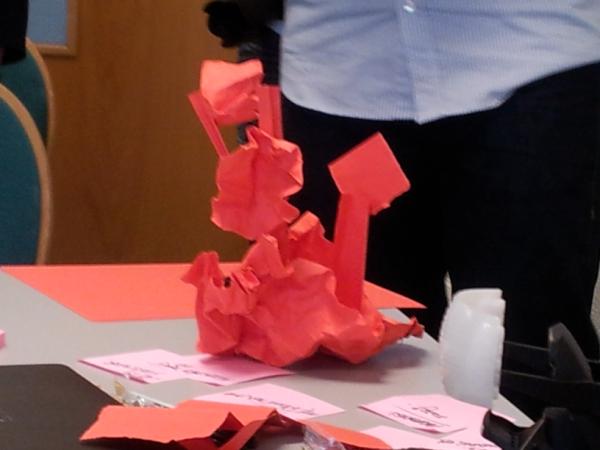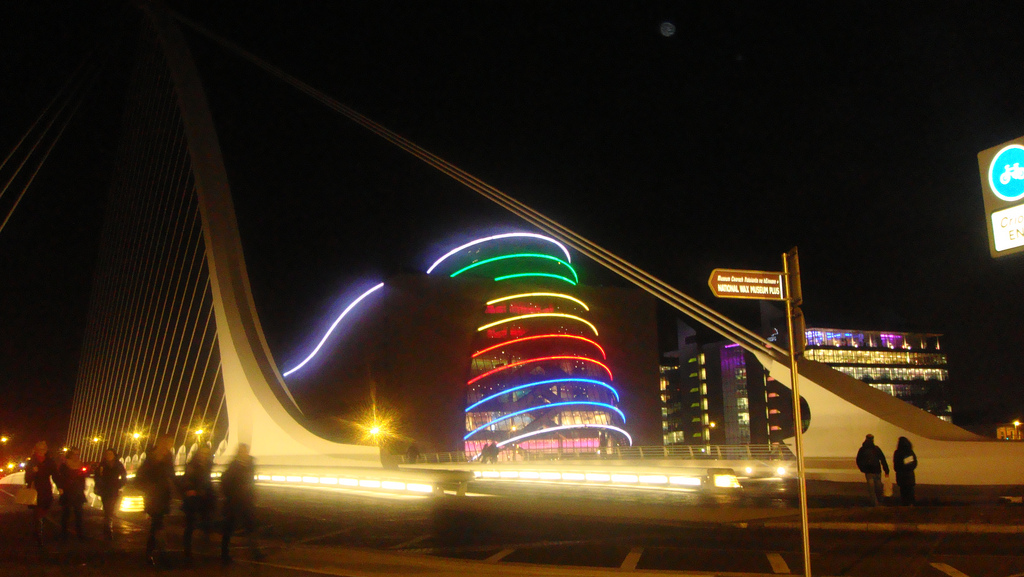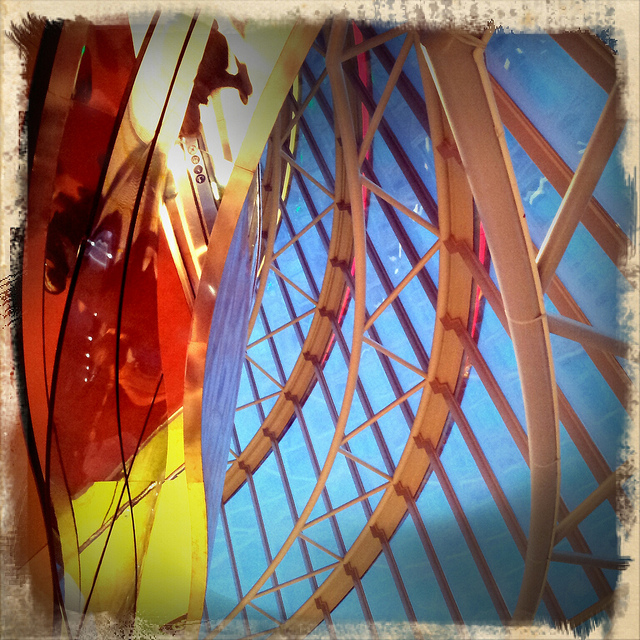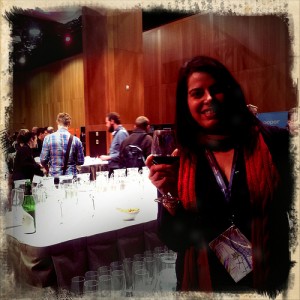My first conference in Ireland… great venue! and I was lucky enough to get hotel in a 3 minutes walking distance. The first day of the conference was reserved for workshops, and it was, in fact, far from the main venue but transport was allocated and everything was well organised.
Wednesday – Workshop
The workshop that I attended was
“What You Missed When You Skipped Design School”
with Dave Malouf (@daveixd) & Matt Nish-Lapidus (@emenel)
Many interaction design practitioners followed organic career paths that allowed then to forgo formal design education, either because such education wasn’t meaningful when they entered the field, or because they decided for good reasons to look elsewhere (HCI, Library Sciences, etc). By skipping design school they miss learning some key foundations of design practice such as criticism, theory, and the studio. They also miss a great experience to learn from experienced designers with their peers.
In this practice-based workshop, you will participate in exercises centered around core concepts in design. The workshop will help you experience, if just for a short while, what happens in a design school and how you can start filling these gaps without getting a Master of Fine Arts.
The workshop will cover four main topics:
Creative & Visual Thinking: Learn how to process and analyze creativity from the designer’s perspective – moving first from imagination, then towards analysis.
Art: Yup, that’s right, we are going to make art. Whether that art is in pixels or construction paper, every design student has to take courses in expressive media such as paint, 3D graphics, or photography. This offers the student new processes for creativity that help them work fluidly in their medium, rather than struggling to control it.
Criticism & Critical Analysis: Often designers are accused of saying they like things “just because.” This happens because people they lack a shared vocabulary to discuss the work at hand. Design criticism helps students learn how to discuss design with other their clients and peers. This section will look at key concepts in theory, criticism, and analysis that are used by many designers regardless of medium.
The Studio: The studio is not a workshop (though it can take place in one). It is a philosophical construct that takes up both space and people’s awareness. A transparent work environment, criticism and collaboration are just some of the concepts that make up a studio environment.
Learning the foundation of these four areas will not only help you improve your own practice, but also your ability to collaborate with other designers and express your designs to clients and coworkers. Join us for a one day immersion in design school!
Both ‘lecturers’ have background and experience in Interaction Design.
For starter a discussion about ‘What is design?’ and I was of the opinion that design is functionality and beauty coming together.
The 5 E’s of design: Experience > Externalise > Envision > Evaluate > Execute
Iams furniture design, his major contribution: wood bending. His tip: understanding and exploring your material to create things that maybe never existed before.
The concept of flow
More innovation coming from cities with more pedestrians, due to collision.
Inspiration – architecture, nature, other designers, music.
Social – interaction that inspire and conversations that have no intention can give birth to amazing ideas.
Studio – is private and social. The buzz, the flow and the interruption of flow, and the way to understand each moment. Studio space should allow collaboration, allow inhibited access “dude, you should move that to 3px left!”. Studio space should be playful (add dart guns, lounge space, etc. IDEO shopping cart movie was mentioned as example of product innovation process – more info on the project from 1999!)
Criticism
Criticism is part of a design process, sometimes the answer is ‘just because’ (just because I felt like the colour blue should be used, etc…) however finding better words for your argument, trying to go deeper on the reasons why a designer chose a particular colour, shape or function makes the analysis of the work more interesting.
In design school there are a few rules of crit:
- ASK, do not tell
- LISTEN, do not defend
So, asking the designer why he chose a particular style, colour, function. Try to get as much information as possible instead of pushing your own opinions. In the same way, the designer should listen to the criticism and analyse if the comment makes sense, instead of defend your creation.
Art and design
Discussion about what is art and what is design. One opinion was that “design have a purpose and art don’t” however, religious art have a purpose, political art also have, and they try to evoke a change of mind, have a ‘beautify’ purpose and can also solve problems.
Examples of Renaissance, Bauhaus & art deco, a Wassily chair designed for a painter. Kitchen Aid mixer that lasted about 100yrs and became icon of the company (included on refrigerators, observe the logo and other elements on their website…).
Design Principles
… maybe even a manifesto …
- Ability to compare and evaluate
- Expose vs construct (“It was inside the marble and I freed it” – Michelangelo)
- Construct to Reconstruct
- Tinkering (exploring materials and possibilities, ex: primary goal of Edgar Degas was painting, did a sculpture of ballerina for exploration
- Refinement (analytical self-evaluation)
- Composition (grid 2/3 filled 1/3 empty)
- Balance – brings moments of relaxation
- Contrasts (in colours, scale) – to clear focus and create attention
- Negative Space (allows to do more with less)
- Scale (to symbolise victory, attention, contrast, etc.)
- Materiality (know the material you work with)
Example of Michelangelo: living and digging in the marble, understanding before mastering, time spent with material.
In UX design “there is no material”, we work with meta-materials: future and people. And the above principles are not the same for interaction design. Plus, the designer’s intention is not always its outcome.
True Grit – apparently you stick with it until you cannot any more > push it > then go back from epiphany.
90% what you do is perspiration, not inspiration – Thomas Edison
One of the first exercises was to use the materials they provided to indicate the idea of ‘time passing’. It was really interesting to have mixed backgrounds on the group because you could see different styles, concepts, inspirations, etc. I drew stages of a tree growing up, almost on comics ‘style’ of frames. Other people had different perceptions: seeing a schedule on paper, a sticky figure presenting or talking about time, hourglass, cave paintings (indicating the evolution), post-it animations, bubbles, tetris or blocks, candle burning (also in frames), tree dying, family tree (generations), farm growth.
Creative Thinking – Feynmann – gave us good tips about creativity
Tips:
- work on the paper (external brain – ‘distributed cognition’)
- try “sketching in 3D space (models)”
- break down problems into smaller pieces, then solve problem and combine them back again
Visual language
- Alphabets using symbols – early criptography
- Sketches from Christopher Alexander (patterns, pattern language), he was sketching with flow through paths, great for physical interactions.
- Event binding
- Multiple interactions
- Comic book: to define the environment, not the object only.
- “Video Sketch”
A sketch is supposed to be disposable, more a question of the designer makes, it is rough, communicate intention.
A prototype will be more a step into completion.
A sketch can also have different levels of zoom, maybe is not the entire object, maybe just a joint, a foot of a chair. Arduino boards – a sketch in electronics!
Another exercise was done, the idea is to model to explore aspects of your time telling. I used glue, coloured paper and use the same idea of the growing of a tree. Some other ideas: water flow (intervention affecting the flow (of time)); circle with animals and numbers, scroll with a story, slide of numbers (always obscuring something but giving the idea of passing the time).

"Angry origamy" by Wil Lau, named by Ambroise in creative session about "your relationship with time"
Some names: Howard Miller – colours, futuristic look and Bauhaus – future (forefront of industrial design)
Shared language
- Foundations: line, plane, volume, value, texture, colour
- Time (rate, duration, frequency)
- Abstraction (distance between user/reality)
- Metaphor (analogy)
- Movement (hard-motion, soft-motion)
Critique has some factors
Intent – what the person is trying to do with the design
Product – what the solution is
Tips/rules of critique:
- focus on the work, not the person
- explain why
- constructive, not instructive (bad example: make it blue! good example: why do you made it green?)
- understand the context
- early and often
- safe environment (open, designer lead)
- ongoing and integrated (on studio)
Work that comes to the studio is in fact done by all. Some own parts of it, more for accountability purposes. Critique needed on a level that design stops or designer needs input (not in a top-down level “let’s do a crit”).
Give reasons why you put things into places, check the colours, etc. Always try to have two reasons for it.
Go back to your designs and look with ‘fresh eyes’, make the implicit explicit (ask why you did this or that).
Emotionally detach yourself from your work to listen the critique.
One article was suggested: “What I got out of design school” by David Armano
Another exercise took place and we develop our ideas even further and would be an opportunity to try the critique techniques explained. A few other ideas appeared: a ‘time-task slider’ where if the task is complete the post-it would be filled with a particular colour, a ‘sketch timer’ where you set up a timer and when the time is up the ink stops to flow (questions on the crit session: ink or lead? how to cut the ink? app/web controller? remote? in industrial design, would be mold injection considered? which material? what are the costs? scalability? size matters (tell us about the scale of the sketch timer…).
Remember to let designers explain their portfolio, is the best way to understand choices and learn more about them.
Books: Elements of Design, Designing for Interactions, Designing for Devices, Design of everyday things
Industrial Designers Current:
- Johnny Ive
- Yves Behar
- Karim Rashid
- Michael Graves
- Phillipe Starck
Past IDs:
- Dieter Rams – Braun
- Charles Eames – Herman Miller
- Raymond Lowie – A LOT
- Henrey Dreyfus – “Human Design”
- John Dewey – Public Edu & Cognitive Psych
- “Art as Experience”(book)
IxD
- Bill Moggrdige – “Designing Interaction” (book), IDEO
- Bill Verplank – IDEO
- Bill Buxton – “Sketching User Experience” (book/workbook)
- Brenda Laurel – Atari, Sun, Art Center, CCA, Apple
- Bruce “Tog” Tognazzini – Apple
- Jef Raskin – Apple
- Alan Cooper – Cooper/Visual Basic
- Dan Saffer – NUI
- Dick Buchanan – Founder of CMU IxD
- Massimo Bansi – Arduino, Physical Computing
- Mike Kuniavsky – “Smart Things” (book)
- David Malouf – UX Zeitgeist
Architects
- Frank Lloyd Wright
- Frank Gehrey
- I.M. Pei
- Ludwig Meis Van De Rohe
- Daniel Leibskind
Thursday to Saturday – Conference
Key talk: Mayor of Dublin – How cities work, how people interact.
He mentioned the bike scheme that was implemented in Dublin as well as in Paris, but the latter implemented first and had a design flaw: as soon as you pay for your bike the bike bay flashes so you can get your bike, but not only you see it, everyone sees it and more than 1000 bikes were stolen on the first year of implementation. Dublin however, learned with their mistake and in 2 years of operation only 2 bikes were stolen – and recovered!!!
Other design problem: in Melbourne the use of helmet is mandatory and the bike scheme has a ‘spontaneous’ nature… this cause the number of journeys to be reduced since people had to carry helmets just in case they wanted to use the bikes at some point during the day. A few stats: Melbourne bike scheme registers between 100 and 200 journeys a day while in Dublin is in between 5000 and 6000 journeys a day.
Disrupt – by Luke Williams
williams.luke@gmail.com
Book: Disrupt
Disrupt to transform the business and find unexpected solutions. Some disruptive companies: Apple (iPhone) was taken aback on mobile development by Google (Android).
Disrupt > Ignore > Spot and React
How to be the disruptive change? Get a predictable routine, same routes, same routine and do something unexpected… Example: flash mob in train station on ‘freezing/not moving’ position for 2 minutes. Craft a disruptive hypothesis (be wrong at the start to be right at the end). Define…
Cliché – more obvious idea of people think and do about business
Interactions cliché – Car rental: face-to-face agent > paperwork > rent a car for the day.
Product cliche – inexpensive, taste sweet, advertised as aspiration
Price cliche – magazine with subscription sale having big discount.
Example: Eurisco – thinking outside the box, the disruptive strategy: on a game of ships general size – sent 1000 defenceless ships – computer lost the game; again new strategy: sink own ships the moment they get damaged – gain agility on other ships – computer lost game again.
A disruptive hypothesis is an intentionally unreasonable “what if” question.
Techniques:
- What can you invert? (The Shining ‘happy’ version of movie trailler; Cliché: inexpensive, sweet taste, aspiration – Inversion: expensive, bad/sour taste – final product: RedBull)
- What can you deny? (Cliché: see customer, loads of paper, rent by the day – Deny: don’t see the customer, no paperwork, don’t rent by the day – final product: ZipCar)
- What can you scale? (Cliché: subscription, 50% cheaper than buying on stand – Scaled hypothesis: subscription is 50% more than buying on stand but gives access to ‘premium’ content – final product: Monocle)
Another cliche: socks are sold in pairs – changed to socks in sets of three (and none of them match!) – Little mismatched – find the niche!!! (in this case, 12yrs old that like mismatching)
Disrupt innovation is not a tactic, it is a mindset, enjoy the possibilities!
Design Language for Interactions by Mike Lemmon
Product design, Ix design, icons and brand – layers: surface, material, colour, function, brand, consumer.
We see design language everywhere (Kitchen Aid, Jacob Jensen, Toshiba…)
Android style guidelines came out recently.
Document the system: philosophy + instruction manual
LAYERS
Consumer – the consumer instead of ‘user’ – the broader the target, harder to connect
Brand – “a brand is a promise” – Porch performance, Volvo safety.
“a brand is a promise”
Structure – “the most elegant products has the less fewer parts” – need no more and cannot afford no less – simplicity comes from the structure, capture the essence of the product.
need no more and cannot afford no less
Interaction – flipboard language (social magazine, when designing a model try to future proof, exercise the use in different devices)
Visuals – don’t underestimate the power of a visual (but have to work on the system!) – Visual elements: colour, typography, layout, icon.
know the rules before you break them!
Examples:
- TDK brand experience – balance analog and digital, the feel of ‘old mix tape’.
- Technicolor
- MGO – top level structure: live tv, tv shows, movies, …
- The new “I’m getting that for you” message, instead of “Loading media”
When you adapt, you diverge, and loose focus…


